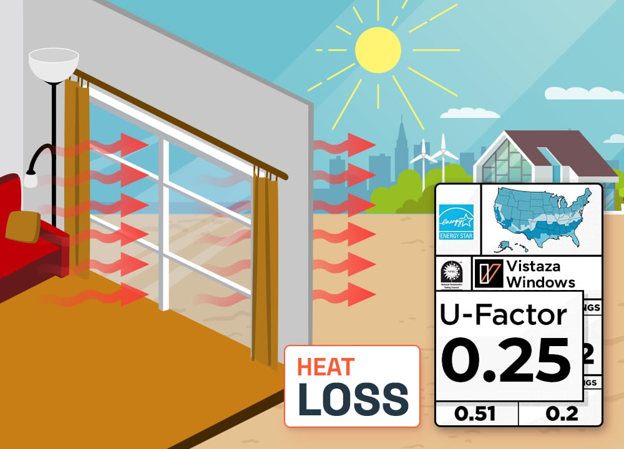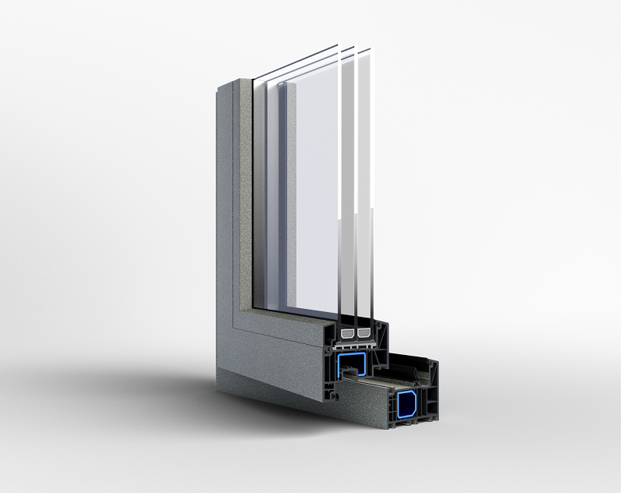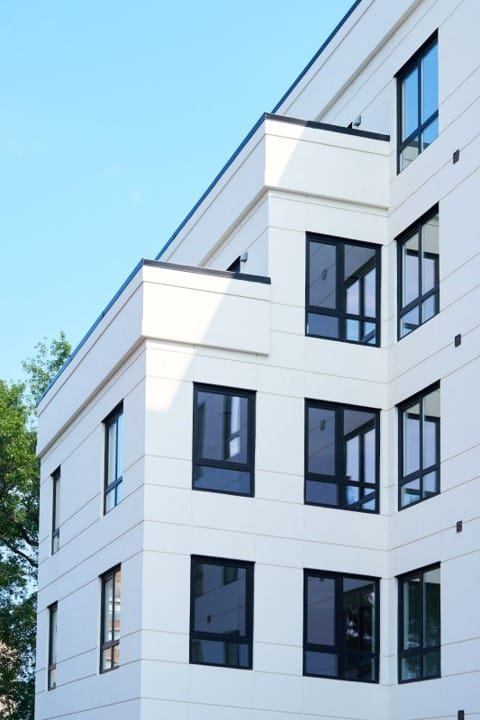In this case study, we will explore the impact of low U-factor windows on the energy efficiency and comfort of a building. Specifically, we will focus on the renovations to Salem Heights, a massive 281-unit development in Salem, Massachusetts, and the role that Vistaza played in supplying triple-pane windows with a low U-factor. These windows have the potential to receive certification from Phius (Passive House Institute US) and have a significant impact on the energy performance and overall comfort of the building.
Salem Heights, owned and operated by Preservation of Affordable Housing (POAH), is a non-profit organization dedicated to providing affordable and healthy homes. The retrofit of Salem Heights presented an opportunity to improve the energy efficiency and comfort of the building while maintaining its affordability. Vistaza, along with other vendors, participated in the retrofit project, providing high-performance windows that were specifically designed to minimize heat loss and maximize energy efficiency.
The Importance of U-Factor
U-factor is the measure of how well a window insulates against heat transfer. It represents the rate of heat loss or gain through a window, with lower values indicating better insulation. A low U-factor means that the window is more effective at preventing heat transfer, resulting in reduced energy consumption for heating and cooling.

When it comes to energy-efficient windows, a low U-factor is crucial. It determines how much heat is transmitted through the window, affecting both thermal comfort and energy usage. Windows with a low U-factor help to keep the interior temperature stable by minimizing heat loss during the winter and heat gain during the summer. This translates to lower heating and cooling costs, reduced reliance on HVAC systems, and improved overall energy efficiency.
The Impact of Low U-Factor Windows at Salem Heights
During the renovation of Salem Heights, Vistaza provided triple-pane windows with an impressively low U-factor of 0.15. These windows were specifically chosen to maximize energy efficiency and thermal comfort. By selecting windows with such a low U-factor, the project team aimed to minimize heat loss and reduce the building’s energy consumption.
The installation of low U-factor windows at Salem Heights has already had a significant impact on the building’s energy performance. The triple-pane design, combined with the low U-factor, provides excellent insulation properties, reducing heat transfer and improving thermal comfort for the occupants. This means that the building requires less energy for heating and cooling, resulting in lower utility bills and a reduced carbon footprint.
Additionally, the low U-factor windows contribute to a more consistent indoor temperature, eliminating cold drafts and hot spots near windows. This enhances the comfort of the residents, creating a more pleasant living environment. The improved thermal performance of the windows also helps to reduce condensation on the interior surface, preventing moisture-related issues such as mold and mildew growth.
Certification Potential from Phius
The retrofit of Salem Heights has the potential to receive certification from Phius, a renowned organization that promotes the design and construction of energy-efficient and comfortable buildings. Phius certification ensures that a building meets rigorous standards for energy performance, comfort, and indoor air quality.
By installing triple-pane windows with a low U-factor, the project aligns with the principles of passive building design advocated by Phius. These windows significantly contribute to the overall energy efficiency of the building and help to create a comfortable and healthy living environment.
While the certification process is still ongoing, the use of low U-factor windows at Salem Heights positions the project favorably. The windows, along with other energy-efficient measures implemented during the retrofit, demonstrate a commitment to sustainability and energy conservation.
The Problem: A Need for Energy Efficient Windows
Salem Heights, a residential complex located in a cold climate zone, was facing numerous challenges due to outdated windows that did not meet the required energy efficiency standards. As a result, the building suffered from heat loss, high utility bills, and discomfort for its residents.
The geographic location of Salem Heights, known for its long and harsh winters, demanded fenestration with high insulation and low heat transmission properties. The National Fenestration Rating Council (NFRC) sets the standards for energy performance ratings, including the U-factor and Solar Heat Gain Coefficient (SHGC), for windows in different climate zones. Unfortunately, the existing windows in Salem Heights failed to meet these requirements.
The outdated windows had a high U-factor, indicating poor insulation and excessive heat transfer. This resulted in increased energy consumption as the heating system had to work harder to maintain a comfortable indoor temperature. Additionally, the windows had a high SHGC, allowing excessive solar heat into the building during the summer months, leading to increased cooling costs.
The Solution: Triple Pane Windows
To address the energy efficiency issues at Salem Heights, Vistaza, a leading window manufacturer, proposed the installation of triple pane windows. These windows are designed with three layers of glass, providing enhanced insulation and reducing heat transfer. The use of triple pane windows with low U-factor and low SHGC ratings would significantly improve the energy performance of the building.

The selected triple pane windows were energy star certified, meeting the stringent energy efficiency criteria set by the NFRC. These windows had a low U-factor, indicating excellent insulation and minimal heat loss. Additionally, they had a low SHGC, meaning they allowed less solar heat to pass through, reducing the reliance on cooling systems during the summer.
Not only did the triple pane windows offer superior energy efficiency, but they also featured uPVC trim on the window frame exterior. This uPVC trim further contributed to the overall energy performance of the windows by providing additional insulation and reducing air leakage.
The Impact: Significant Energy Savings
The installation of triple pane windows with low U-factor and uPVC trim had a substantial impact on the energy efficiency of Salem Heights. The improved insulation properties of the windows significantly reduced heat loss during the winter months, resulting in lower energy consumption and reduced heating costs for the building.
Additionally, the low SHGC of the windows prevented excessive solar heat from entering the building during the summer, reducing the need for air conditioning and lowering cooling costs. The combination of low U-factor and low SHGC ratings created a more comfortable indoor environment for the residents, with consistent temperatures and reduced drafts.
According to energy performance calculations, the replacement of the outdated windows with energy-efficient triple pane windows resulted in a significant percentage reduction in energy consumption. The residents of Salem Heights experienced improved comfort and lower utility bills, making their living spaces more sustainable and cost-effective.
How Vistaza Can Help
If you are facing energy efficiency challenges in your existing building, Vistaza can help. With a wide range of energy star certified windows, including triple pane options, Vistaza offers solutions that meet the highest standards of energy performance.
Contact Vistaza today to explore how their energy-efficient windows can transform your building and create a more sustainable environment for you and your residents. Improve the energy performance of your building and contribute to a greener future with Vistaza’s high-quality replacement windows.




